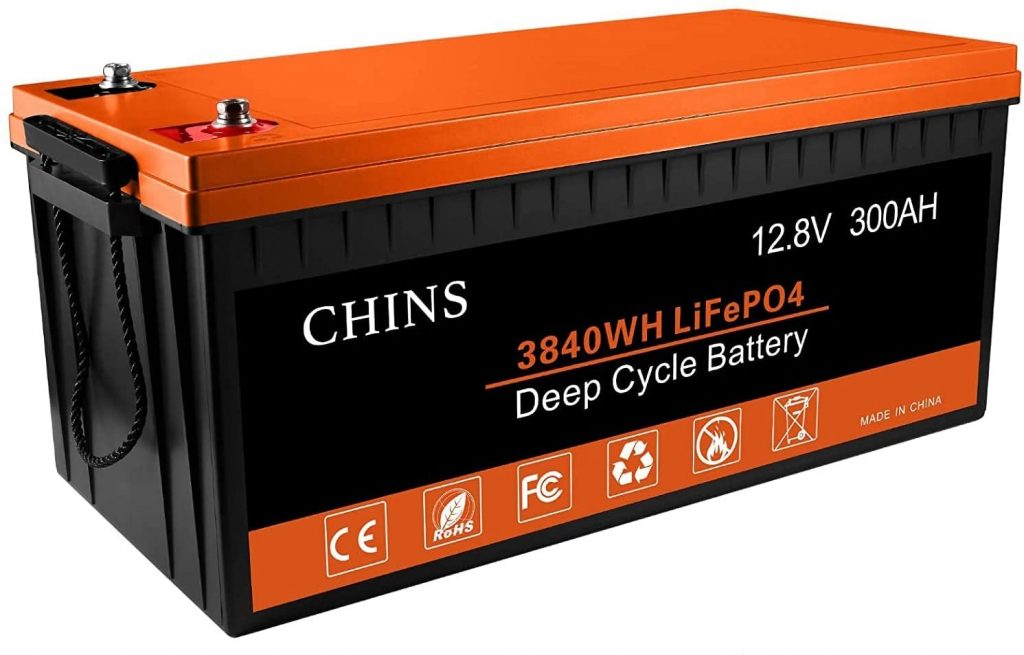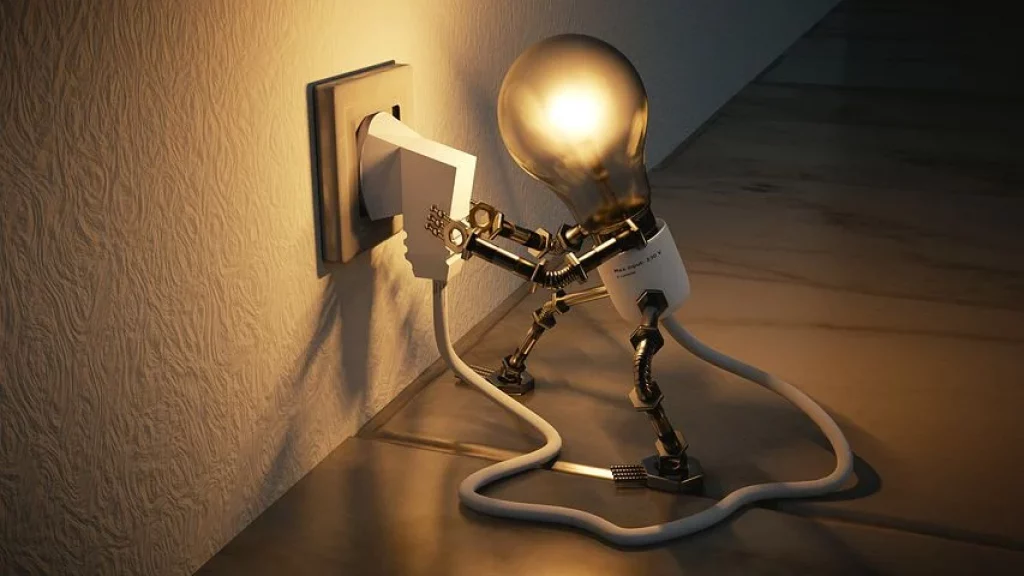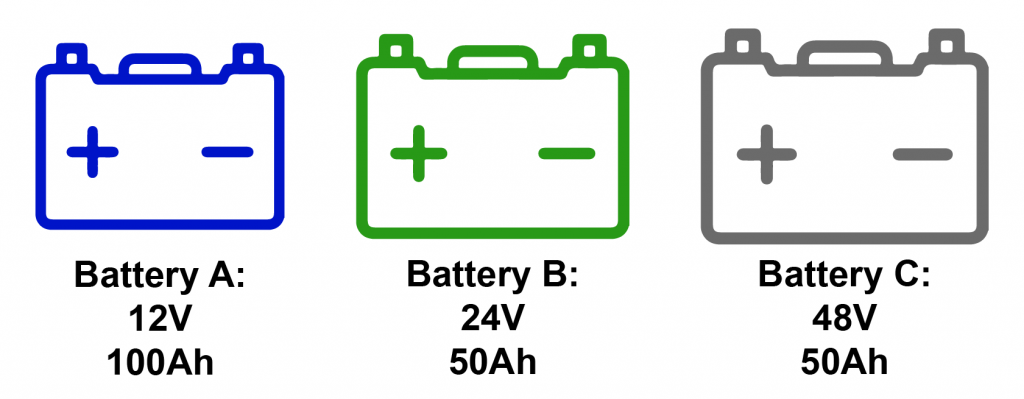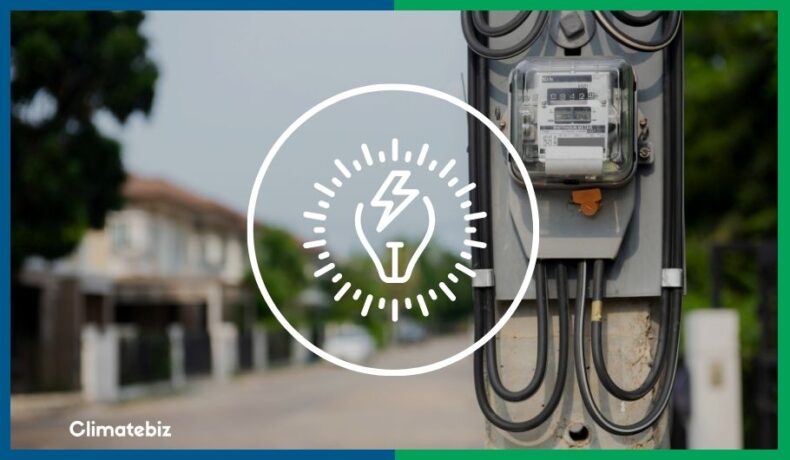Need to convert Ah to Wh? We’ll show you how!
Understanding battery specs can be pretty confusing, right? Nevertheless, understanding both amp-hours and watt-hours is crucial to ensuring you don’t suddenly run out of power when it comes to solar batteries.
Especially if your goal is to use your battery to run devices in your RV or campervan, figuring out how much power you’ll need should be at the top of your list of priorities. After all, you don’t want to end up stuck with a dead battery or running out of juice in the middle of nowhere.
If you’re new to the game, it’s normal to feel overwhelmed when figuring out how many watt-hours your battery bank has/needs. It’s all amps and volts and conversions, and before you know it, you’re lost.
But don’t worry, in this article, we’ll show you how to convert Amp-hours to Watt-hours in no time!
This way, you’ll know precisely how many Ah you need to meet your power demand (expressed in Wh).
Let’s get started!
Table of Contents
Is Ah The Same As Wh?
No. While both units (Ah and Wh) are used to express battery capacity, they are not the same.

Amp-hour — short for Ampere hour — is a unit of electric charge. It describes the charge capacity of a battery, meaning the amount of current drawn/delivered for a certain amount of time.
Meanwhile, a Watt-hour is a unit of electrical energy. It describes the energy capacity of a battery. In other words, it expresses the amount of energy a battery can store or deliver.
Basic Concepts of Electricity
To better understand the differences between Ah and Wh, let’s first review a few relevant concepts:
1. Current: the rate at which electrons flow through a point in an electrical circuit. In short, current = flow of electrons. The unit of current is ampere (A).
2. Voltage: voltage is the pressure at which the current moves through an electrical system. This provides electrical energy, which can perform work, like drying your hair when you use a hairdryer. The unit of voltage is volt (V).
3. Energy: energy exists in various forms: thermal, chemical, nuclear, mechanical, electrical, etc. In short, energy is the capacity for doing work.
In the realm of electricity, energy results from the movement of electrically charged particles, like electrons, for instance.
The SI unit of energy is Joule (J). However, there are other units of energy. The unit for electrical energy is Watt-hours (Wh). Wh is equivalent to Joule, as we’ll explain shortly.
4. Power: the amount of energy transferred or converted per unit of time. The unit for power is expressed in watts (W). A watt has the same dimensions as energy divided by time.
5. Electric charge: a physical property that causes matter to experience a force within an electromagnetic field. It can be positive (protons) or negative (electrons). The unit of charge is the coulomb (C).

With these definitions in mind, we can move to a more detailed explanation of the differences between Ah and Wh.
Amp Hour (Ah)
Amp-hour is commonly used to express battery capacity. It tells you the current (in amps) that can be drawn/delivered for a certain amount of time (measured in hours).
Example
Let’s take a 100Ah battery as an example. If you continuously draw 100 amps from this battery, you’ll completely deplete it in one hour. Drawing 50 amps, you’ll deplete it in two hours.
If you draw 20 amps continuously, how many hours will it take you to discharge this 100Ah battery fully? You guessed it right, 5 hours. Do you see the logic here?
Similarly, if you deliver 10 amps continuously to charge this 100Ah battery, you would take 10h to fully charge it (10A x 10h = 100Ah).
Note that amp hour is not a measurement of electrical energy. As previously mentioned, amp hour is a measurement of charge. Confused? Let’s elaborate on that:
You’ve seen that the unit of charge is the coulomb (C), which can be defined as the charge delivered by an electric current of one ampere (1A) in one second.
Dimensional Analysis
If we do a dimensional analysis, we’ll see that amp hours is equivalent to coulomb (C):
[C] = [1A] x [1s] (current times time) and [Ah] = [1A] x [1h] (current times time)
The only “difference” is that one uses seconds, and the other uses hours to measure time. (And 1 hour = 3600 seconds, so 1Ah = 3600C)
Therefore, we’ve confirmed that an amp hour is a unit of charge.
So when you see Ah being used to express battery capacity, you’ll know that this number indicates the charge capacity of this battery. In other words, it tells you the current that can be provided for a certain amount of time (in hours).
Charge capacity (Ah) = current (A) x time (h)
It has no relation to the amount of energy that this battery can provide.
To know the amount of energy a battery can store/deliver, you need to consider both the voltage at which the current flows through the system and the amount of current during a certain period. For this, we use watt-hour.
Watt Hour (Wh)
As previously mentioned, watt-hour is a measurement of energy. When a battery’s capacity is expressed in Wh, what is actually being expressed is the battery’s energy capacity.
It indicates the amount of current this battery can store/provide and the amount of energy (a product of power and time). The voltage (the “pressure” with which the current flows through the circuit) is considered with Wh.
Let’s check the equations for energy and power:
Energy (Wh) = power (W) x time (h) and Power (W) = current (A) x voltage (V)
If we replace power for its definition in the equation for energy, we get that:
Energy (Wh) = current (A) x voltage (V) x time (h)
Notice that the voltage is the difference between the last equation and the equation for charge capacity (Charge capacity = current x time).
Therefore, Wh and Ah are not the same units. One is a unit of energy (Wh), and the other is a unit of charge (Ah).
Dimensional Analysis
Let’s demonstrate that Wh and Joule (the SI unit of energy) are equivalents:
Joule can be described as the work required to produce one watt of power for one second:
[J] = [1W] x [1s] (watt times time) and [Wh] = [1W] x [1h] (watt times time)
Therefore, we’ve confirmed that a watt-hour is a unit of energy.
Amp Hours To Watt-Hours Conversion Chart
If you’re in a hurry to convert Ah to Wh, we’ve got you covered!
We’ve prepared an Ah to Wh conversion chart with the most common battery capacities (in Ah) and voltages for battery storage systems:
| Amp-hours | 12V | 24V | 36V | 48V |
|---|---|---|---|---|
| 10 Ah | 120 Wh | 240 Wh | 360 Wh | 480 Wh |
| 20 Ah | 240 Wh | 480 Wh | 720 Wh | 960 Wh |
| 50 Ah | 600 Wh | 1200 Wh | 1800 Wh | 2400 Wh |
| 80 Ah | 960 Wh | 1920 Wh | 2880 Wh | 3840 Wh |
| 100 Ah | 1200 Wh | 2400 Wh | 3600 Wh | 4800 Wh |
| 150 Ah | 1800 Wh | 3600 Wh | 5400 Wh | 7200 Wh |
| 200 Ah | 2400 Wh | 4800 Wh | 7200 Wh | 9600 Wh |
| 250 Ah | 3000 Wh | 6000 Wh | 9000 Wh | 12000 Wh |
| 300 Ah | 3600 Wh | 7200 Wh | 10800 Wh | 14400 Wh |
It’s important to note that these numbers are theoretical. In practice, efficiency losses decrease the amount of energy (Wh) a battery can provide.
How Can You Convert Ah To Wh?
Converting Ah to Wh (Amp-hours to Watt-hours) is much easier than it may seem.
In short, you need to multiply the Ah by the system’s voltage. This operation will give you the result in Wh:
Energy (in Wh) = capacity (in Ah) x voltage (in Volts)
In terms of units: Watt-hours = Amp-hours x Volts
Or simply Wh = Ah x V
Example 1
You have a 12V battery with 200Ah of capacity. If you want to know how many watt-hours this battery can store/deliver, the only operation you need to do is:
Energy (Wh) = capacity (in amp-hours) x voltage (V)
Energy = 200Ah x 12V = 2400Wh
Therefore, 2400Wh is the amount of energy this battery can store or provide.
A Brief Explanation
The key to this conversion is knowing that:
1. Watt-hours is the unit of electrical energy. It expresses the amount of power sustained (store/delivered) for one hour. It is also a measure of energy consumption; how many watts you consume in one hour.
Energy (Wh) = power (W) x time (h)
2. Amp-hours is a unit of electric charge. When it comes to batteries, it expresses the battery capacity. In other words, it tells you how the amount of current (in amps) the battery can store/deliver in one hour.
Charge (Ah) = current (A) x time (h)
3. Power is the amount of energy transferred or converted over time.
Power (W) = Energy (Wh) / time (h)
In the field of electricity, you can also calculate power using:
Power (W) = Current (A) x Voltage (V)
With these things in mind, you’ll easily understand the conversion from Ah to Wh.
Here’s The Idea
If energy (in Wh) is the amount of power (in watts) sustained for an hour and power is the product of current (in amps) and voltage (in volts); then replacing the formula for power with the formula for energy results in:
Energy (Wh) = current (A) x voltage (V) x time (h)
Notice something familiar? Now the formula for charge (Amp-hours = current x time) appears in the formula for energy.
If we rewrite current (A) x time (h) for charge (Ah), we conclude that:
Energy (Wh) = charge (in amp-hours) x voltage (V)
To convert Ah to Wh, you simply multiply Ah by the system’s voltage.
How Can You Convert Wh To Ah?
To convert Wh to Ah, you simply divide Wh by the system’s voltage. This operation will give you the result in Ah.
Charge (in Ah) = energy (in Wh) ÷ voltage (in Volts)
In terms of units: Amp-hours = Watt-hours ÷ Volts
Or simply Ah = Wh ÷ V
Example 1: You have a 12V portable power station with an energy capacity of 3600Wh. What’s the charge capacity (Amp-hours) of the batteries in this power station?
Charge capacity (Ah) = energy (Wh) ÷ voltage (V)
Charge capacity (Ah) = 3600Wh ÷ 12V = 300Ah
Therefore, the battery capacity of the power station is 300Ah.
What Is The Reason To Convert?
There are two main reasons:
1. Comparing Batteries In Terms of Their Capacity
Converting Ah to Wh (and vice-versa) makes it easier to compare the capacity of different batteries directly.
Considering only the amp-hours of batteries can be misleading because the amount of energy a battery can store/provide depends on both its amp hours and voltage.
Example
Let’s use the batteries below as examples:

Source: Climatebiz
If we consider only the Amp-hours (charge capacity) of each battery, we could say that batteries B and C have the same capacity; therefore, if they powered the same appliance with the same current, they would last just as long.
We could also say that battery A has more capacity than battery B and battery C. And that battery A has the same capacity as battery B and battery C combined.
But, would these assumptions be correct?
As you probably suspected, no, these assumptions are not correct.
To compare different batteries in terms of how much power they can provide and for how long, you must use watt-hours (energy capacity).
Let’s calculate the energy capacity of each battery (A, B and C):
- A: Wh = Ah x V = 100Ah x 12V = 1200Wh
- B: Wh = Ah x V = 50Ah x 24V = 1200Wh
- C: Wh = Ah x V = 50Ah x 48V = 2400Wh
Now we can compare these batteries appropriately.
Looking at the watt-hour (energy capacity) of each battery, we notice that:
- Despite having the same charge capacity (amp-hour) as battery B, battery C can provide more energy (Wh).
- Despite having a larger charge capacity (Ah) than battery B, battery A provides the same amount of energy (Wh).
- Battery C, despite having a lower charge capacity (Ah) than battery A, can provide double the amount of energy of battery A.
See? When comparing batteries, you must look at the number of watt-hours they can provide as only considering Ah will likely lead you to erroneous conclusions.
2. Determining The Size of Your Battery System
In addition, one of the most important parts of planning your solar battery system is estimating your energy demand. Doing so will help you determine the size of your battery system.
Since most appliances are rated according to how much power they consume, once you account for all your appliances and the amount of time you’ll use each one, you’ll reach a total in watt-hours.
However, most batteries have their capacity expressed in amp-hours.
Therefore, to compare apples to apples, you’ll need to convert Ah to Wh (or vice versa), considering the voltage you plan on using in your battery system.
Examples
If your energy demand was 4320Wh and the voltage of your battery system was 12V, you’d need 360Ah of battery capacity:
Ah = Wh ÷ V = 4320Wh ÷ 12V = 360Ah
For this system, you could use two 200Ah 12V batteries to build a system with 400Ah (always a bit more than your actual energy demand because of efficiency losses).
Alternatively, if you had a battery system with a 24V 100Ah battery and you wanted to know how much energy this battery could provide, you’d need to use:
Energy (Wh) = Ah x V = 100Ah x 24V = 2400Wh
So the maximum amount of energy this system would be able to provide would be 2400Wh.
FAQ
Why is it important to know both Ah and Wh when dealing with batteries?
While Ah gives you an idea of the charge capacity of a battery, Wh provides information about the energy capacity. Knowing both helps in comparing batteries, determining the size of your battery system, and understanding how long a battery can power a device.
Is a higher Ah always better for a battery?
Not necessarily. While a higher Ah indicates a larger charge capacity, the energy capacity (Wh) also depends on the voltage. For instance, a 50Ah battery at 48V can provide more energy than a 100Ah battery at 12V.
Do real-life battery efficiencies affect these conversions?
The numbers provided by the Ah to Wh conversion are theoretical. In real-life scenarios, efficiency losses and other factors can decrease the actual amount of energy a battery can provide. Always consider these factors when planning or comparing battery systems.
Final Thoughts
Whether you’re trying to save on energy costs or working on a new DIY solar project, being able to convert Ah to Wh can come in handy. What’s more, it’s a very valuable skill to have when estimating what battery bank size is right for you.
The Ah to Wh conversion calculator and chart provided in this article can be beneficial tools for quickly figuring out watt-hours from amp hours or vice versa.
But rest assured, we’ve provided all the necessary tools to encourage you to convert between these two units yourself. Once you get the hang of it, you’ll realize it’s relatively simple.
Hopefully, this article has helped you understand a little more about this topic. As always, feel free to reach out to us in the comment section or the climatebiz forum if you have any questions.

